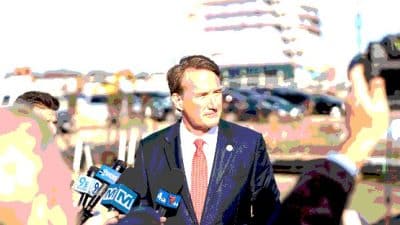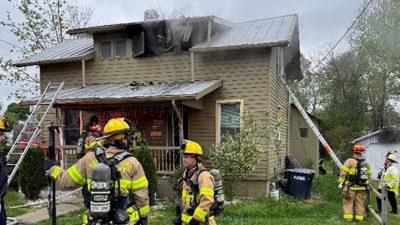
[email protected]
You know, considering how much a gallon of gas is costing us today, and how dramatically much less we’re driving these days, maybe it’s not such a bad thing that our General Assembly left Richmond last month once again without having come up with a solution to our transportation crisis.
I say that because I’m thinking that maybe the infrastructure deficiencies that we’ve been experiencing for the past decade on I-81 in Western Virginia and up along I-66 and the Beltway in NoVa and I-64 and its environs in Hampton Roads will almost come to a point of resolving themselves in future years just out of a joint mutual recognition of our fiscal realities.
“I don’t think it will resolve itself, because regardless of what happens with fuel prices, we’re going to need more funding for transportation alternatives such as transit, freight rail. But I think where we may be lucky is that we didn’t strike the deal that was on the table, the asphalt-centered deal. That’s where I would completely agree with you, that we will look back and say we were lucky we didn’t pour even more money into a system that doesn’t fit our future needs very well,” said Trip Pollard, a senior attorney with the Charlottesville-based Southern Environmental Law Center and the director of the Center’s Land and Community Project, in a conversation with me about transportation and Virginia last week.
And actually, I would tend to lean more to Pollard’s analysis of the situation than my own more drastic one above. Because for one thing, even as we’re hearing the news that we’re driving a lot less than we used to – 20 billion, with a b-, fewer vehicle miles this year, according to the United States Department of Transportation – that’s still only a reduction of about 2 percent overall from where we had been a year ago. Which is to say, it’s not as if we’re all the sudden all biking or walking or riding mass transit or telecommuting, or anything like it. But even Pollard has shifted his life a bit, moving to Richmond from Charlottesville in part because his job has him in the capital city so much that he decided that it would make sense to cut down on his commuting as much as he could.
The $64,000 Question of the day has to do with the effect that these kinds of individual decisions – people like Pollard moving to be closer to their jobs, for instance – will have on macro-level planning decisions made in Richmond and Washington about the transportation networks of the future. Will we necessarily just give up the freedom of the road that we have become so accustomed to as Americans with interstate highways linking us and cars and trucks fueled by cheap gasoline getting us to where we want to go because that cheap gasoline appears to be forever gone?
“If you assume that the prices that we are seeing are in fact going to be with us for a very long time, that’s not an unreasonable notion. But my thought is that planners are probably making too much of this, that reporters are making too much of this. People are saying, At last we’ve reached the tipping point. America is about to turn into Prague. It ain’t. It is a very big mistake to premise the future on something that we’ve seen for the past six to eight months,” said Alan Pisarski, a noted transportation expert and author and NoVa resident.
Pisarski points to similar Chicken Little-like predictions that the sky was falling in 1974 and 1979 when gas prices rose to levels similar to what we’re experiencing now when accounting for inflation and how “we bounced back from those just fine.” That said, accounting for inflation, there’s a sticker-shock factor today that probably rightly has up all up in arms, though even that is relative, according to Pisarski. “Believe me, when I pay $80 to fill up a tank of gasoline, it comes as as a shock to me. And it does defer my thinking. On the other hand, my wife and I were just in Europe, and we were paying $9 a gallon, and got stuck in a traffic jam with a bunch of Europeans paying $9 a gallon.”
So it doesn’t seem that Pisarski is on board with my idea that we’re going to see some sea change in the way we plan for our transportation future. More on that later. I also talked last week with John Lawson, the director of the financial planning division at the Virginia Department of Transportation, to learn more about what VDOT is doing, or as the case may be, not doing, to respond to the decline in vehicle miles traveled in terms of planning for the future of the Old Dominion’s transportation infrastructure. Lawson walked me through an effort under way at VDOT called VTrans 2035 that has transportation planners squarely focused on that endgoal. “This planning activity that is getting under way now looks to the future and what are the trends and needs of the highway and transit systems, and what the funding needs are going to be to address those. I think what you’re talking about is a long-range planning activity to see if our thoughts about vehicle miles traveled are going to continue holding off or getting smaller, and I think you’re right. I think this 2035 initiative will do a lot of what you’re talking about. What are the future needs?” Lawson told me.
Pollard, for one, doesn’t think the transportation planners in Richmond are going far enough to that end. “You’re seeing the first phase of shift in thinking in at least some metro-area and state-level planning, but it’s lagging,” Pollard said. “Both the planning and the policy tends to lag the reality a bit, and I think the people have been ahead of the policymakers on this one. For example, we raised over two years ago in our comments on the proposed I-81 widening in the environmental-impact statement the need to look at the impact of rising fuel prices on demand and what would that mean in turn for what was the best project. And VDOT refused to consider that.”
Which brings me back to Pisarski and his notion that what we’re doing now is not lagging behind but overreacting. “From a point of view of an economist, you think short term, long term,” Pisarski said. “The short-term stuff is sort of a no-brainer. You park the low-fuel-efficiency vehicle and you use the high-fuel-efficiency vehicle in your fleet, if you have such, and that happens instantaneously. You start carpooling within the household. You start looking around for other people to travel with. Those kinds of decisions. And that can in fact go a long way. In the longer term, you start buying more fuel-efficient vehicles, you start thinking about, Gee, I’m going to have to move because I got a new job, but I think this time I’m going to have to live closer than I did last time.
“The most likely reaction will be in the fuel economy of the vehicles that we drive. We will see the continuation of the travel behavior of the past. Obviously a little bit of the arithmetic has changed – and by arithmetic I mean the tradeoff between time and the cost of operating a vehicle. I think that is almost the dispositive understanding of what the public is going to do and what it isn’t going to do,” Pisarski said.










